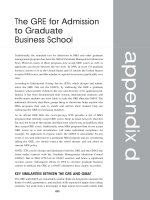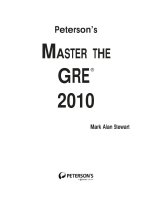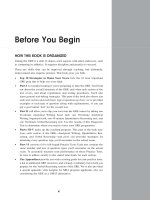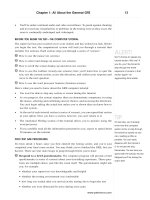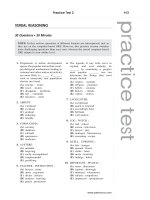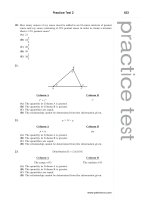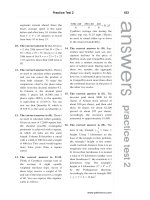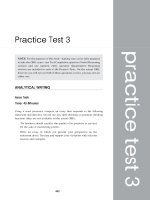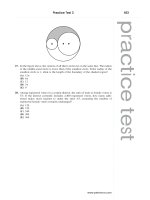Tài liệu Master the Gre 2010 - Part 51 pptx
Bạn đang xem bản rút gọn của tài liệu. Xem và tải ngay bản đầy đủ của tài liệu tại đây (111.1 KB, 10 trang )
the culture subject to stricter and more
uniform laws than fields in which indi-
vidual creation prevails. Folk tales do
contain certain variable elements—for
example, the distribution of points of
emphasis and the nomenclature (vocation)
and attributes of the dramatic personae—
through which the teller’s own personality
and inclinations may find expression.
Also, the teller’s choice among the rep-
ertory of the available genres (for
example, fairy tales and anecdotes) and
among the known tales within each genre
often reflect the teller’s preferred manner
of execution, while the teller-narrator
typically assumes whichever character
most closely resembles the teller. Never-
theless, whereas in written literature a
creative personality is free to shape
entirely new roles, including that of nar-
rator, in storytelling all characters are
predetermined by the tale. Attempts at
biographical interpretation almost
invariably fail to convince; the tale must
come before the teller.
23. It can be inferred from the passage
that the author would most probably
agree with which of the following
statements about classic novels?
(A) They should not be considered
part of the collective property
of a culture.
(B) They are sometimes adapted
from a culture’s well known
folk tales.
(C) They place less emphasis on
dramatic personae than fairy
tales and anecdotes do.
(D) They use a culture’s language
in more imaginative ways than
folk tales.
(E) They often resemble folk tales
insofar as they belie their
author’s own values and
attitudes.
24. The passage as a whole can appro-
priately be viewed as
(A) an examination of the ways in
which story tellers imbue
well-known folk tales with their
own personalities
(B) an explanation as to why
tellers of folk tales generally
choose to conform to cultural
expectations in how they tell
their tales
(C) an investigation into certain
parallels between language in
general and folk tales in
particular
(D) an argument that folk tales
evolve over time as a result of
both cultural shifts and
individual creativity
(E) a description of the extent of
the consistencies generally
observed among a region’s folk
tales
25. When it was constructed, the gym-
nasium was highly _______; the stu-
dents for whom it was planned were
_______, but community members
who faced losing their neighborhood
park were outraged.
(A) controversial . . gratified
(B) warranted . . skeptical
(C) fortuitous . . euphoric
(D) unnecessary..impartial
(E) desirable . . numerous
26. IMPEDE:
(A) comply
(B) hasten
(C) deny
(D) engulf
(E) progress
27. AGILE : DANCER ::
(A) delicious : fruit
(B) diligent : worker
(C) barren : desert
(D) tall : building
(E) dangerous : criminal
practicetest
Practice Test 4 483
.................................................................
..............................................................................................
www.petersons.com
28. Shakespeare’s _______ of Richard III
is so _______ that it is difficult to
imagine that the ruler had been dead
for more than a century before the
Bard cast him as the central char-
acter in one of his plays.
(A) rendition . . compelling
(B) criticism . . candid
(C) depiction..vivid
(D) portrayal . . droll
(E) caricature..inventive
29. VAGARY:
(A) full disclosure
(B) explicitness
(C) impartiality
(D) essential element
(E) foreseeable event
30. FAWN:
(A) insult
(B) dominate
(C) grow stronger
(D) win over
(E) boast
PART VI: Five Practice Tests484
.................................................................
..............................................................................................
www.petersons.com
QUANTITATIVE REASONING
28 Questions • 45 Minutes
NOTE: In this section, questions of different formats are interspersed, just as
they are on the computer-based GRE. However, this practice session contains
more challenging questions than easy ones, whereas the actual computer-based
GRE adapts to your ability level.
1. The toll for driving on road A is $1.20 for the first mile and 35 cents for each
additional mile. The toll for driving on road B is $2.25 for the first mile and 20
cents for each additional mile.
Column A
Column B
The toll for a 8-mile drive
on road A
The toll for a 8-mile drive
on road B
(A) The quantity in Column A is greater.
(B) The quantity in Column B is greater.
(C) The quantities are equal.
(D) The relationship cannot be determined from the information given.
2. k . 0
Column A
Column B
kk
12 12
+
k
(A) The quantity in Column A is greater.
(B) The quantity in Column B is greater.
(C) The quantities are equal.
(D) The relationship cannot be determined from the information given.
3. Each of 18 students is taking either Spanish or German, or both. More than 50
percent of the students are taking both languages.
Column A
Column B
The number taking German
but not Spanish
The number taking Spanish
but not German
(A) The quantity in Column A is greater.
(B) The quantity in Column B is greater.
(C) The quantities are equal.
(D) The relationship cannot be determined from the information given.
practicetest
Practice Test 4 485
.................................................................
..............................................................................................
www.petersons.com
4. If n is the least of two consecutive odd integers, and if the difference of their
squares is 120, which of the following equations can be used to find their values?
(A) (n +1)
2
2 n
2
= 120
(B) n
2
2 (n +2)
2
= 120
(C) [(n +2)2 n]
2
= 120
(D) n
2
2 (n +1)
2
= 120
(E) (n +2)
2
2 n
2
= 120
5. A faucet is dripping at a constant rate. By noon on Sunday, 3 ounces of water
have dripped from the faucet into a holding cup. If a total of 7 ounces have
dripped into the cup as of 5 p.m. the same day, how many ounces altogether will
have dripped into the tank by 2:00 a.m. the following day?
(A) 10
(B)
51
5
(C) 12
(D)
71
5
(E)
81
5
6. Two square rugs R and S, which have a combined area of 20 square feet, are
placed on a rectangular floor whose area is 112 square feet, as shown above.
Measured east to west, each rug is placed the same distance from the other rug as
from the nearest east or west edge of the floor. If the area of rug R is four times
the area of rug S, how far apart are the rugs?
(A) 3 feet, 4 inches
(B) 3 feet
(C) 2 feet, 8 inches
(D) 2 feet
(E) 1 feet, 6 inches
PART VI: Five Practice Tests486
.................................................................
..............................................................................................
www.petersons.com
7. Shown below is a correct problem in addition, with R and S representing different
digits.
7R
RS
RR
——
117
What is the value of S ?
Write a number in the box.
8. Referring to the above graph, if there are 140 trees altogether on Main Street,
how many of the trees are pine?
(A) 40
(B) 24
(C) 21
(D) 15
(E) 14
Column A
Column B
9. The least common
multiple of 4, 6, and 8
The greatest common
factor of 44, 66, and 88
(A) The quantity in Column A is greater.
(B) The quantity in Column B is greater.
(C) The quantities are equal.
(D) The relationship cannot be determined from the information given.
practicetest
Practice Test 4 487
.................................................................
..............................................................................................
www.petersons.com
